
Augmented Intelligence Teams: How AI is Transforming Businesses
Artificial intelligence (AI) has taken the world by storm and revolutionised how we live and work. Its applications are diverse, ranging from predictive analytics and natural language processing to autonomous machines and chatbots. As competition in the business world gets fiercer, AI has become crucial for companies that want to stay ahead.
From ChatGPT’s groundbreaking announcement of GPT-4 to Microsoft’s 365 Copilot AI integration, the future of work is now. However, the true potential of AI lies in its ability to augment human intelligence and capabilities rather than replace them. The rise of Augmented Intelligence Teams (AIT) represents a new paradigm for work, where humans and machines collaborate to drive innovation, creativity and productivity to new heights.
Through the creation of AIT, organisations can transform into “Augmented Enterprises” (AE) where AI enhances human decision-making, problem solving and creativity.
In this blog, we will explore the critical role of AIT in transforming organisations into Augmented Enterprises. We will also look at the key design patterns for successful AIT and explore the technical considerations of adopting AI in the workplace.
Understanding Augmented Intelligence Teams (AIT)
Augmented Intelligence Teams (AIT) represent a new paradigm of team collaboration where AI and humans work together to achieve common goals. By leveraging AI technologies, AIT can enhance human capabilities and decision-making, enabling organisations to achieve new levels of productivity, innovation and competitiveness.
AIT differs from traditional teams in that it places equal emphasis on the capabilities of both humans and machines, with each team member contributing their unique strengths and insights.
Benefits of AIT for organisations
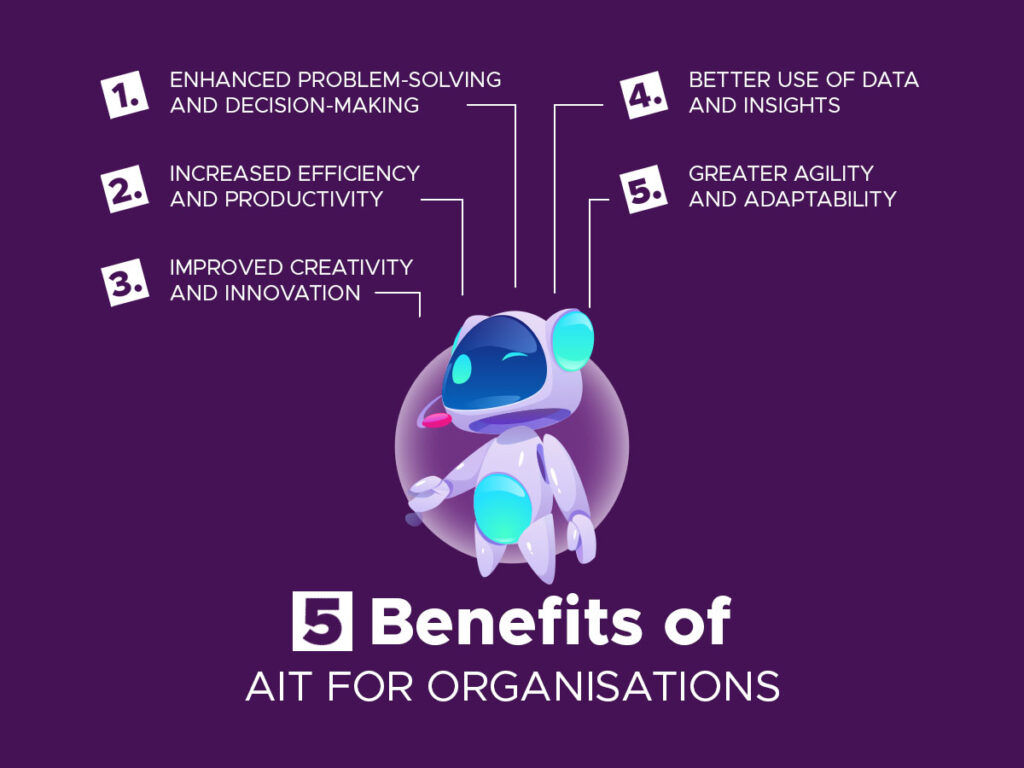
AIT can deliver many benefits to organisations, which can help improve workplace performance in several ways.
- Enhanced problem-solving and decision-making
AIT can help organisations make better decisions and solve complex problems faster by giving them access to more data and insights and advanced analytics tools that can process large amounts of information in real-time. With AIT, businesses can rely on data-driven insights to make more informed decisions, reduce the risk of errors and improve the quality of decision-making.
- Increased efficiency and productivity
AIT can automate routine tasks and help other team members work more efficiently, reducing the time and resources needed to complete tasks. With AIT, companies can streamline their workflows, reduce the burden on employees and give them more time to focus on high-value tasks.
- Improved creativity and innovation
AIT can help teams develop new ideas and solutions by providing fresh perspectives and insights into complex problems. By augmenting human creativity and imagination, AIT can unlock new opportunities for innovation and help organisations stay ahead of the competition.
- Better use of data and insights
AIT can help companies extract more value from their data by automating data processing and analysis and generating new insights and recommendations. With AIT, organisations can quickly identify trends, patterns and anomalies in their data to make more informed decisions and improve business outcomes.
- Greater agility and adaptability
AIT can help companies respond more quickly to changes in market and customer demand and identify new opportunities for growth and expansion. Through faster decision-making and real-time insights, AIT can help organisations stay nimble and responsive in a rapidly changing business environment.
Recommended reading: Cracking the Code for Successful Outsourcing Experience
Building an Augmented Enterprise (AE)
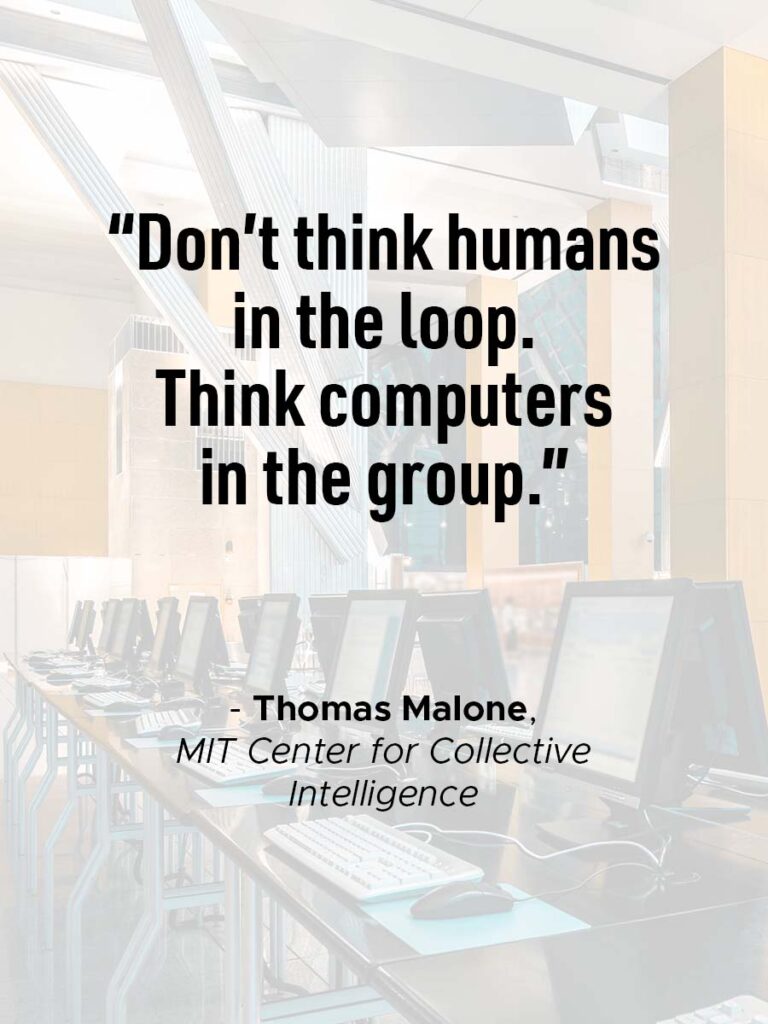
“Don’t think humans in the loop. Think computers in the group” — Thomas Malone, MIT Center for Collective Intelligence.
Imagine the possibilities if your organisation could become smarter, more adaptable and better equipped to meet the growing demands of your customers and stakeholders. What if you could unlock the true potential of data, analytics and artificial intelligence (AI) by combining them with human knowledge? That is exactly the promise of building an augmented enterprise (AE).
AE is an organisation that harnesses the power of augmented intelligence teams (AIT) to achieve new levels of innovation, collaboration and competitiveness. By combining the unique strengths of human intelligence with AI capabilities, AEs can create a culture of continuous learning, experimentation and improvement to deliver better outcomes for customers, employees and stakeholders alike.
Building an AE offers several benefits, including:
- Effective use of AI to drive innovation and competitiveness
A recent study at Harvard Medical School found that an algorithm could accurately detect breast cancer 92% of the time, while a human pathologist achieved a slightly higher rate of 96%. However, when the two worked together, the accuracy rate rose to an impressive 99.5 %.
These results show the enormous potential of AI when integrated into key business processes and workflows. By leveraging AI technology, organisations can unlock a host of new opportunities for innovation and growth, resulting in a more agile and competitive business.
- Better collaboration and communication across teams and functions
On 16 March 2023, Microsoft made a major announcement regarding its latest innovation, AI Copilot.
This breakthrough tool is designed to work with Word, Excel, PowerPoint, Outlook, Teams and other Microsoft 365 tools to unlock productivity, unleash creativity and improve skills. According to Microsoft, “Copilot will fundamentally change how people work with AI and how AI works with people”.
By harnessing the power of Copilot and collaborating in augmented teams, employees can unlock new levels of productivity, share knowledge and insights, identify new opportunities and drive innovation.
- Enhanced customer experience and outcomes
Leading companies such as Netflix and Capital One Travel are leveraging the power of artificial intelligence to improve the customer experience and drive business growth.
By personalising content recommendations, Netflix has created a tailored and engaging user experience, while Capital One Travel uses AI to analyse airfares, make predictions about deals and provide hyper-personalised recommendations to its customers.
The use of AI-powered chatbots is also on the rise as companies realise the potential of these intelligent tools to deliver exceptional omnichannel customer experiences. By using AI to better understand customer needs and preferences, businesses can provide personalised and relevant experiences that drive customer loyalty and satisfaction.
Recommended reading: The Role of BPO in Expanding Global Market Reach
AI Change-Readiness Factors
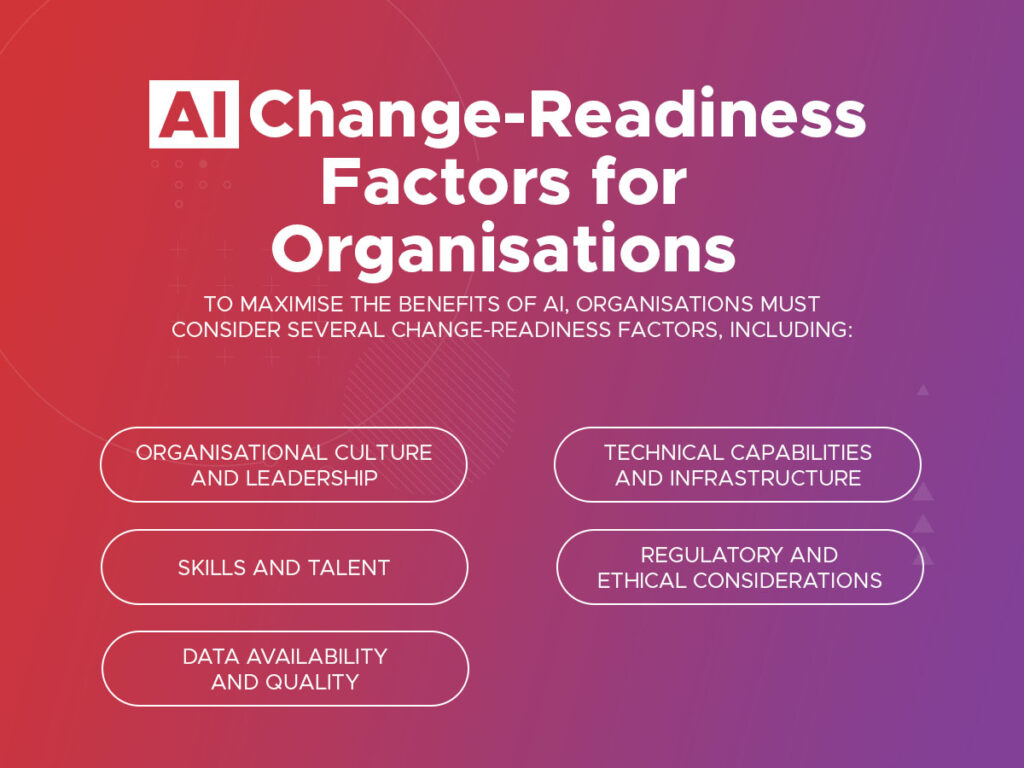
While the promise of AI is immense, effective implementation of AI requires careful consideration of a range of factors that impact an organisation’s ability to adapt and leverage AI technologies.
To maximise the benefits of AI, organisations must consider several change-readiness factors, including:
- Organisational culture and leadership: Successful AI implementations require a culture of innovation and experimentation with leaders who can drive change and create an enabling environment for experimentation and learning.
- Skills and talent: Implementing AI requires various technical and business skills, including data science, machine learning, and project management. Companies must invest in training and hiring the right talent to support AI initiatives.
- Data availability and quality: AI is only as good as the data it is trained on. Therefore, organisations must ensure they have access to high-quality data that is relevant to the problems they are trying to solve.
- Technical capabilities and infrastructure: AI requires robust technical capabilities and infrastructure to support the processing, storage and analysis of big data. Organisations need to ensure they have the right tools and infrastructure in place to support AI initiatives or at least leverage existing AI systems.
- Regulatory and ethical considerations: As AI becomes more prevalent in enterprises, there are growing concerns about issues such as privacy, bias, and transparency. Companies must take a proactive approach to address these concerns and ensure that their use of AI is ethical and responsible.
Common challenges and how to address them
Despite the potential benefits, implementing AI is not without challenges. Below are some of the most common challenges organisations face when implementing AI and how to overcome them:
- Resistance to change: Implementing AI often requires significant changes to organisational processes and culture, which can be met with resistance from employees. To address this challenge, organisations must invest in change management and digital transformation programmes that build awareness, understanding and support for AI initiatives.
- Lack of clarity and alignment on AI strategy: Organisations must have a clear and well-defined AI strategy that aligns with business goals and objectives. Without a clear strategy, it is difficult for companies to prioritise initiatives or achieve meaningful results.
- Data silos and poor-quality data: AI is only as good as the data it is trained on, and many organisations struggle with data silos and poor-quality data. To address this challenge, organisations must implement data governance policies and invest in data management initiatives that break down data silos and improve data quality.
- Skills gaps and talent shortages: Implementing AI requires various technical and business skills. Organisations must invest in training and hiring the right talent to support AI initiatives. They can also partner with universities and other organisations to develop a pipeline of AI talent.
- Bias and ethical concerns: As AI becomes more prevalent in business, companies must consider the ethical and regulatory implications of using AI, including privacy and security issues. To address this challenge, organisations must establish ethical guidelines and governance frameworks to ensure that AI is used responsibly and transparently.
Best Practices for Designing AIT
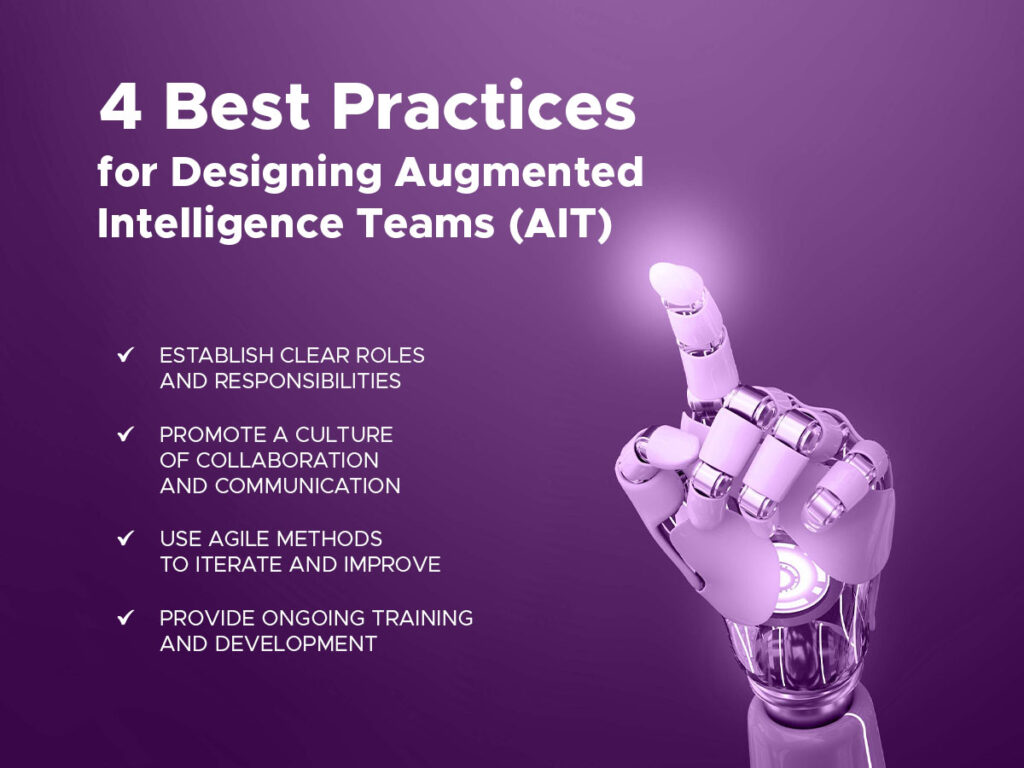
Building effective augmented intelligence teams (AIT) requires careful planning and consideration. The following are some best practices for designing AIT that can help organisations achieve their goals:
- Establish clear roles and responsibilities: The design of AIT should begin with a clear understanding of the roles and responsibilities of both the AI and human team members. This includes defining the AI’s scope of work, setting clear expectations for human team members, and establishing guidelines for decision-making and escalation procedures.
- Promote a culture of collaboration and communication: Collaboration and communication are key to successfully creating AIT. It is important to create a culture of open communication where team members feel comfortable sharing their ideas and insights. This can be achieved through regular team meetings, brainstorming sessions, and other collaborative activities.
- Use agile methods to iterate and improve: Agile methodologies can help organisations quickly iterate and improve their AIT design. By adopting an agile approach, organisations can quickly respond to feedback and make changes that improve the effectiveness of their AIT. This includes breaking projects into small, manageable iterations, regularly reviewing progress, and adjusting as needed.
- Provide ongoing training and development: AIT design requires a range of technical and business skills. Organisations should provide ongoing training and development opportunities to ensure team members have the skills they need to work effectively. This includes training on AI technologies, as well as soft skills such as collaboration, communication, and critical thinking.
Strategies for optimising team performance with AI
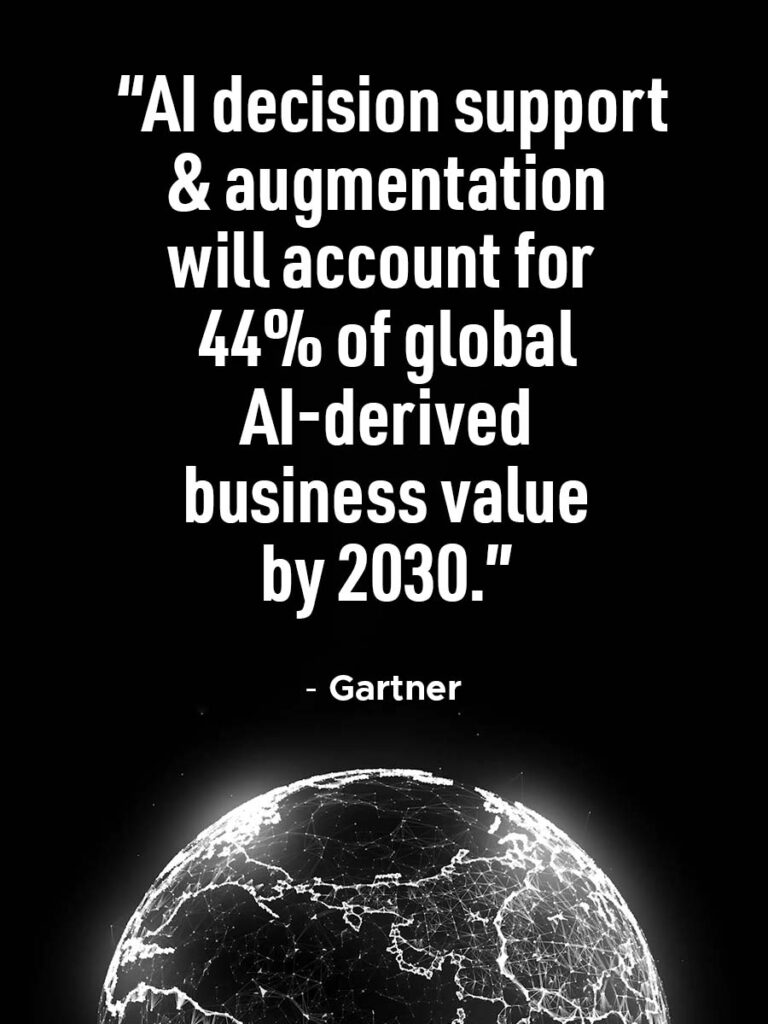
With the advent of AI, organisations can revolutionise how teams collaborate and ultimately optimise performance. According to Gartner, AI decision support and augmentation will account for 44% of global AI-derived business value by 2030.
This means companies must leverage AI to stay ahead of the curve. By optimising team performance using AI, companies can gain a competitive advantage in today’s data-driven world.
Below are some strategies for effectively optimising team performance using AI:
- Identify specific pain points and use cases
Start by identifying specific challenges in your team’s workflow where AI can improve efficiency, productivity or decision-making. Use cases range from automating routine tasks to improving customer service to providing real-time language translation for global teams.
- Integrate AI tools into existing workflows
To optimise team performance with AI, it is essential to integrate AI tools into existing workflows. This can be done by integrating AI capabilities into existing applications or by using third-party tools that work with existing systems. By integrating AI into existing workflows, Microsoft helps teams and businesses work efficiently.
- Use AI to augment, not replace, human decision-making
While AI can improve decision-making and productivity, it is important to remember that AI cannot replace human decision-making. Use AI to augment human decision-making, but be sure to include human team members in the process.
- Use AI to gain insights and recommendations
AI can help teams gain new insights and recommendations to improve performance. By analysing data on team performance, AI can identify patterns and trends that human team members may miss and make recommendations to improve productivity, collaboration and decision-making.
For example, AI-powered project management tools such as ProofHub, Trello’s Strategy-AI and ClickUp can analyse team performance data to provide insights into team productivity, identify bottlenecks and inefficiencies, and suggest strategies for improvement.
Recommended reading: Ultimate Guide to Employee Background Check in Nigeria
Use Cases of AIs in Organisations
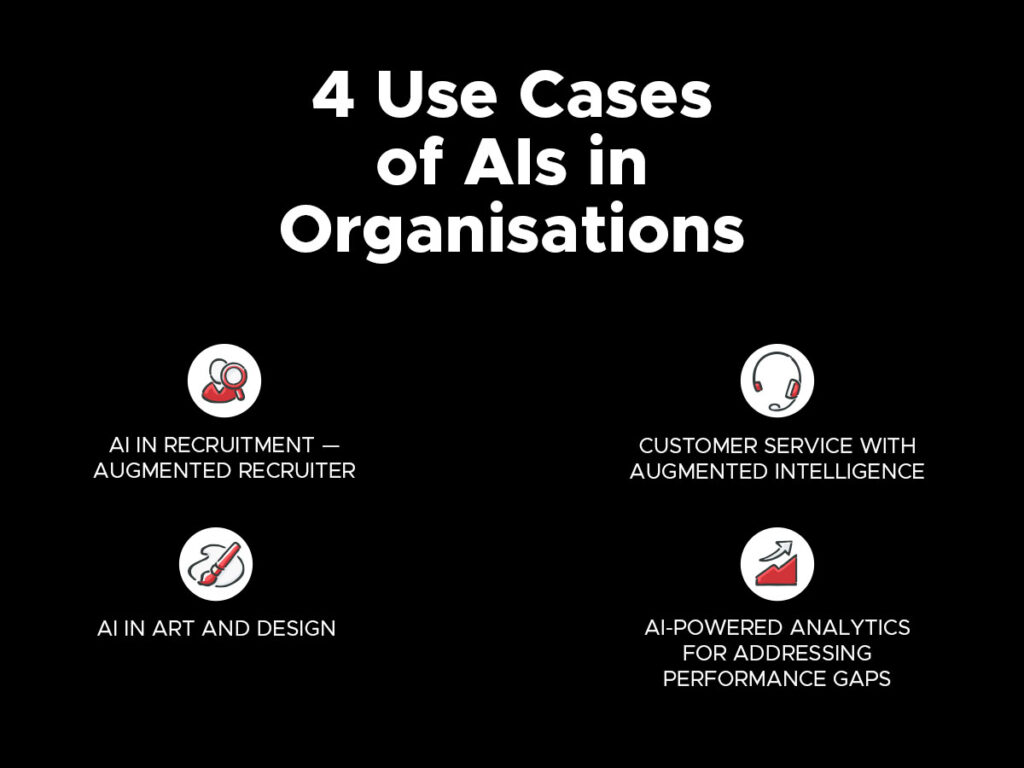
There is a common misconception that AI is here to replace humans and take over our jobs. However, the reality is quite different. For professionals, it is not about competing with AI but with other professionals using AI to their advantage.
As more organisations adopt AI, it becomes increasingly important for professionals to use this technology to stay competitive in the job market. By working with AI, professionals and AITs can achieve more and gain a competitive advantage in their industry.
There are many use cases for AI in business; here are just a few examples:
AI in recruitment — Augmented recruiter
AI is revolutionising the recruitment industry and making it more efficient to find the best candidates for open positions. Augmented recruiters are AI-powered tools that automate manual and time-consuming tasks so recruiters can focus on higher-value activities.
Findem, for example, allows companies to find candidates based on technical and intangible attributes in a way that traditional keyword matching cannot. Paradox offers an AI assistant tool that communicates with candidates via text.
AI in Art and Design
Canva and Adobe are leading the way in using AI to enhance the creative process in art and design. Canva’s recent introduction of AI-powered tools such as Assistant, Magic Write, Magic Design, Magic Edit and Magic Eraser have streamlined the design process for users. The company has also launched Beat Sync and a translation feature to improve the user experience.
Similarly, Adobe has launched Firefly, an AI-powered tool that allows users to quickly modify images by typing commands. With Firefly, users can generate different versions of images using AI technology.
Customer service with augmented intelligence
According to Forrester, improving the customer experience is a top priority for 72% of companies. A study by NewVoiceMedia also shows that poor customer service costs businesses over $62 billion. To address this challenge, companies are turning to AI-powered chatbots that provide round-the-clock support and automate responses to common questions to improve the overall customer experience.
Walmart, for example, acquired Canada-based Botmock in late 2021 to provide automated help and recommendations to customers via voice and chat. Other major companies such as Unilever, Nike and eBay are also using AI-enabled chatbots to improve customer service.
AI-powered analytics for addressing performance gaps
Organisations can use AI-powered analytics tools to identify patterns and trends in large data sets and close performance gaps. This information can help leaders and stakeholders more objectively assess employee performance and eliminate biases that can occur in traditional performance evaluations.
This approach can save HR professionals and managers significant time and resources.
Metacog, for example, is an AI-powered human performance analytics solution that can be used to assess and improve individual and team performance. This tool can also help bridge the gaps between synthetic training environments and real-world performance.
With McKinsey predicting that half of today’s work activities could be automated by 2055, companies need to use AI-powered analytics tools to stay competitive and improve employee performance.
Choosing the Right Tools and Technologies
- Evaluating different AI vendors and solutions
To start, evaluate and compare different AI vendors and solutions based on cost, features, and performance. It is important to assess how well the AI solution fits with your existing technology stack and identify any potential integration issues that could arise.
- Aligning technology choices with business objectives
Next, align technology choices with your business objectives to ensure that they contribute to the organisation’s overall success. Consider scalability, ease of use, and automation potential when evaluating AI solutions. By identifying specific business problems that AI can help solve, you can better tailor the technology to meet your specific needs.
- Ensuring data privacy and security
Finally, data privacy and security are critical considerations when implementing AI technologies. Ensure that data is stored and processed in compliance with data protection laws and industry standards. For instance, if you are using an AI-powered analytics tool to track employee performance, you must ensure that the data collected is secure and that the tool complies with data privacy regulations.
What Does The Future Look Like for AIT and Organisations?
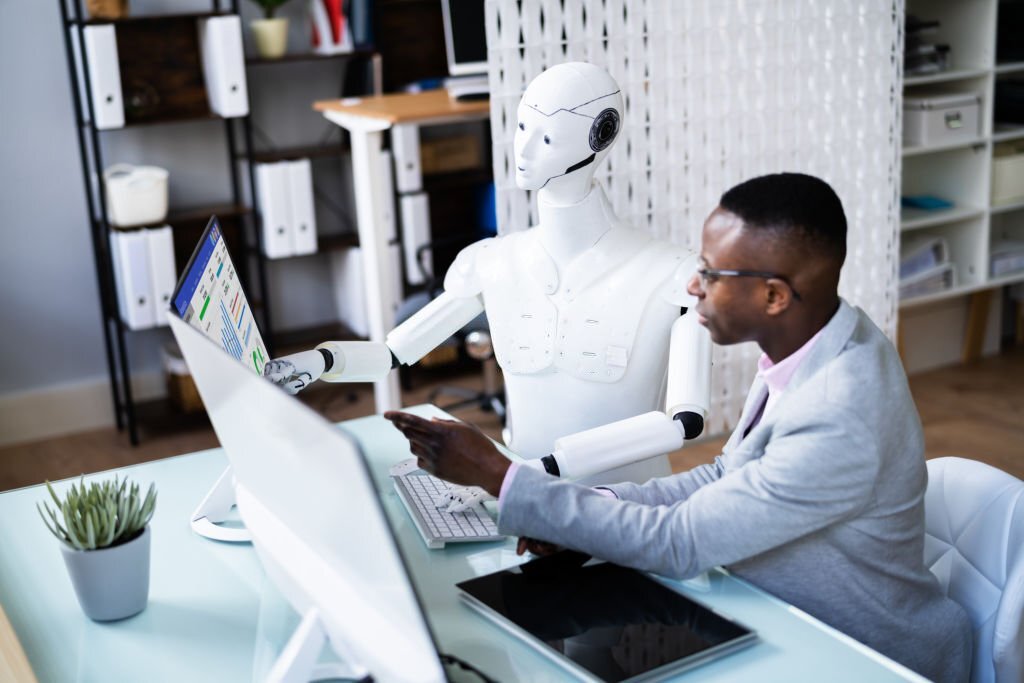
The future of work is inextricably linked to the role of augmented intelligence in supporting business decisions. As organisations continue to focus on growth and innovation, the combination of human expertise and AI algorithms will become increasingly critical for scaling at speed and achieving success.
However, AI will not replace human capabilities but rather work alongside humans to achieve even greater success.
To remain competitive and innovative, companies will rely on augmented intelligence teams (AIT) whose effectiveness depends on investments in technology and talent. This includes investing in the right technology and recruiting best-fit candidates, and fostering a culture that values data-driven decision-making.
By building robust AITs, companies can develop into augmented enterprises (AEs) and position themselves for success in the new world of work.
The future belongs to forward-thinking organisations that recognise the value of augmented intelligence and invest in the technology and talent necessary to leverage its potential.










